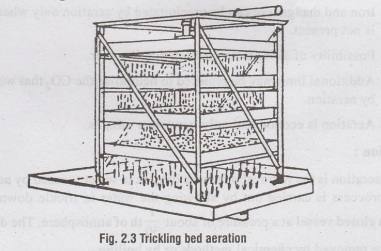It is an important unit operation of gas transfer. In this process, water is brought in intimate contact with air, so as to absorb oxygen and to remove carbon dioxide gas.
AERATORS OF FLASH MIXERS
• It is an important unit operation of gas transfer.
• In this process, water is brought in intimate contact with air, so as to absorb oxygen and to remove carbon dioxide gas.
Objectives of aeration are:
(i) It removes tastes and odours caused by gases due to organic decomposition.
(ii) It increases the dissolved oxygen in water.
(iii) It removes the hydrogen sulphide and odour produced.
(iv) It decreases carbondioxide of water thereby reduces its corrosiveness and raises its pH value.
(v) It converts iron and manganese, from soluble and insoluble state so that these can be precipitated and removed.
(vi) It kills bacteria to some extent.
(vii) It helps in mixing of chemicals.
Types of Aerators :
The aeration of water can be carried out in the following ways:
1. Spray Nozzles: In this method, water is sprinkled in air or atmosphere through special nozzles which breaks the water into droplets, thus permitting the escape of dissolved gases. It requires considerable head of water (0.75 to 1.5 kg/cm2) required for the working of nozzles. The nozzles function efficiently at a pressure of 10 to 14 m head of water. The carbon dioxide gas is removed upto 90%.
2. Cascade aerators: It is the simplest form of gravity or free fall aerator. Weirs and waterfalls of any kind are cascade aerators. A simple cascade consists of a series of three or ten steps of concrete or metal. Water is made to fall through a certain height (1 to 3m) over a series of steps, and due to this it comes into close contact with air (atmospheric oxygen). These aerators take large quantities of water in a comparatively small area at low head. They are simple and easily cleaned. They are made of robust and durable materials with a long life. The plates are made of cast iron, RCC, timber or glass. The aerators are preferably installed in open air, or may be in a room which has plenty of louvered air inlets. The cascade aerators are efficient in raising dissolved oxygen content of water, but CO, removal is only in the range of 60 to 70%.

3. Air diffusion: In this method, perforated pipe network is installed at the bottom of the aeration tank, and compressed air is blown through these pipes. The vino compressed air is bubbled up from the bottom of the tank. As the air bubbles olqu bovou travel upward, it gets thoroughly mixed up with the water in the tank, thus causing aeration. Air diffuser basins have a retention period of about 15 minutes and a depth of 3 to 5 metres.

4. Trickling beds (Gravel bed aerators): In this method, the water is allowed to trickle down the beds of coke, limestone or anthracite supported over the perforated bottomed trays, arranged vertically in series. Generally, three beds are used, the depth of each being about 0.6m with a clear distance of about 0.45m inbetween. The water is applied from the top through perforated distribution pipes and allowed to trickle down, up to the bottom bed. During this downward motion, the water gets mixed up with air, and aeration takes place. The size of the coke used ranges between 50 to 75mm. This method is better than cascades, but less effective than spray nozzles. This method is more efficient in CO, removal than other methods.

5. Inclined apron aerator with riffle plates: In this type of aerator, water is allowed to fall along an inclined plane or apron which is usually studded with riffle plates in herring bone fashion. The breaking up of the sheet of water will cause agitation of water and 
Limitations of Aeration :
Aeration has the following limitations :
(i) It is not an efficient method of removal or reduction of tastes and odours caused by chemical released from industrial wastes.
(ii) Aeration may add more oxygen in water making it more corrosive and may necessiate de-aeration.
(iii) Iron and manganese can be precipitated by aeration only when organic matter is not present.
(iv) Possibility of air borne contamination in water.
(v) Additional lime may be required to neutralise the CO, that would be removed by aeration.
(vi) Aeration is economical only in warmer months.
De-aeration :
De-aeration is the removal of excess oxygen in water (caused by aeration). The de- aeration proccess is carried out by allowing the water to trickle down through gravel layers in a closed vessel at a pressure of about 1/30th of atmosphere. The dissolved oxygen can also be removed by chemical methods or by boiling.
No comments:
Post a Comment